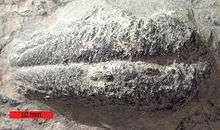Rusophycus
| Rusophycus | |
|---|---|
 | |
| Rusophycus trace fossil from the Ordovician of southern Ohio. Scale bar is 10 mm. | |
| Trace fossil classification | |
| Kingdom: | Animalia |
| Phylum: | Arthropoda |
| Ichnogenus: | Rusophycus |
Rusophycus is a trace fossil allied to Cruziana.[1] Rusophycus is the resting trace, recording the outline of the tracemaker; Cruziana is made when the organism moved.[2] The sculpture of Rusophycus may reveal the approximate number of legs that the tracemaker had, although striations (scratchmarks) from a single leg may overlap or be repeated.
Both Rusophycus and Cruziana are typically associated with trilobites but can also be made by other arthropods.[3] Rusophycus is known from sediments dating to the earliest Cambrian Period (somewhat before the first appearance trilobite fossils), and from the Triassic Period (after the Permian extinction of trilobites), indicating that other producers could make the trace.[4]
References
- ↑ Baldwin, C. T. (1977). "Rusophycus morgati: an asaphid produced trace fossil from the Cambro-Ordovician of Brittany and Northwest Spain". Journal of Paleontology. 51: 411–425.
- ↑ Garlock, T. L.; Isaacson, P. E. (1977). "An occurrence of a Cruziana population in the Moyer Ridge Member of the Bloomsberg Formation (Late Silurian)-Snyder County, Pennsylvania". Journal of Paleontology. 51 (2): 282–287. JSTOR 1303607.
- ↑ Woolfe, K. (1990). "Trace fossils as paleoenvironmental indicators in the Taylor group (Devonian) of Antarctica". Palaeogeography, Palaeoclimatology, Palaeoecology. 80 (3–4): 301–310. doi:10.1016/0031-0182(90)90139-X.
- ↑ Donovan, S. K. (2010). "Cruziana and Rusophycus: trace fossils produced by trilobites … in some cases?". Lethaia. 43 (2): 283–284. doi:10.1111/j.1502-3931.2009.00208.x.
This article is issued from
Wikipedia.
The text is licensed under Creative Commons - Attribution - Sharealike.
Additional terms may apply for the media files.